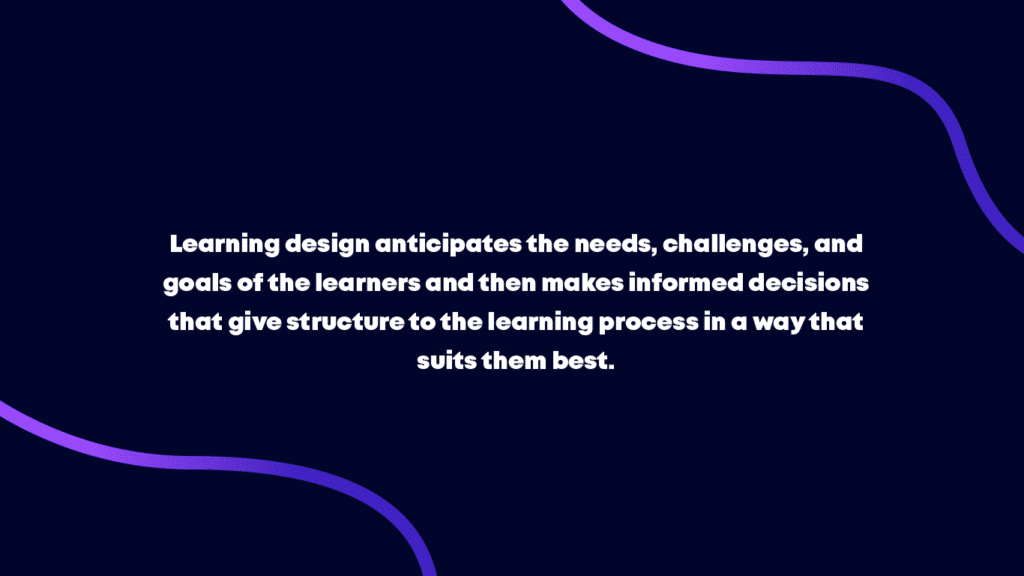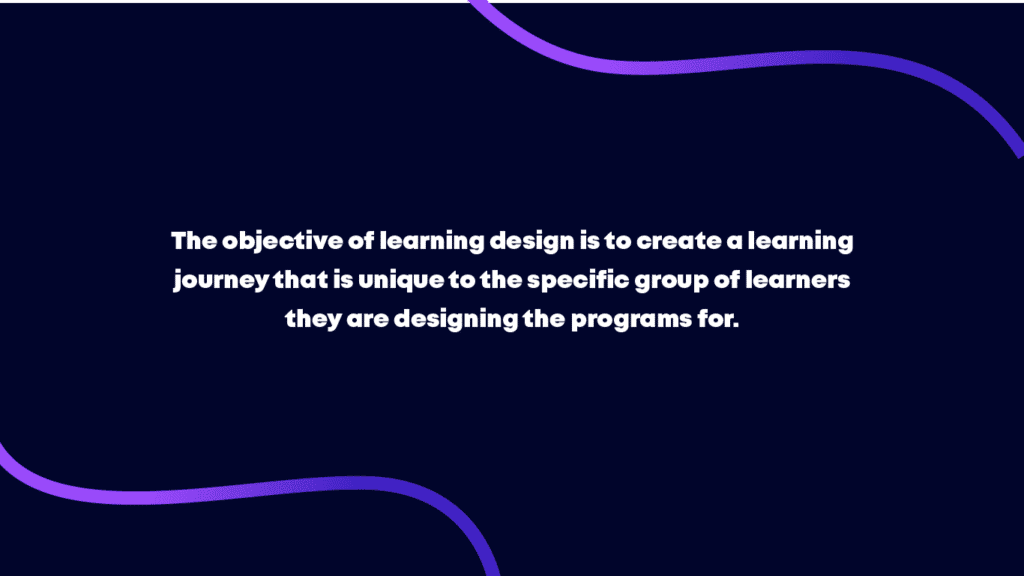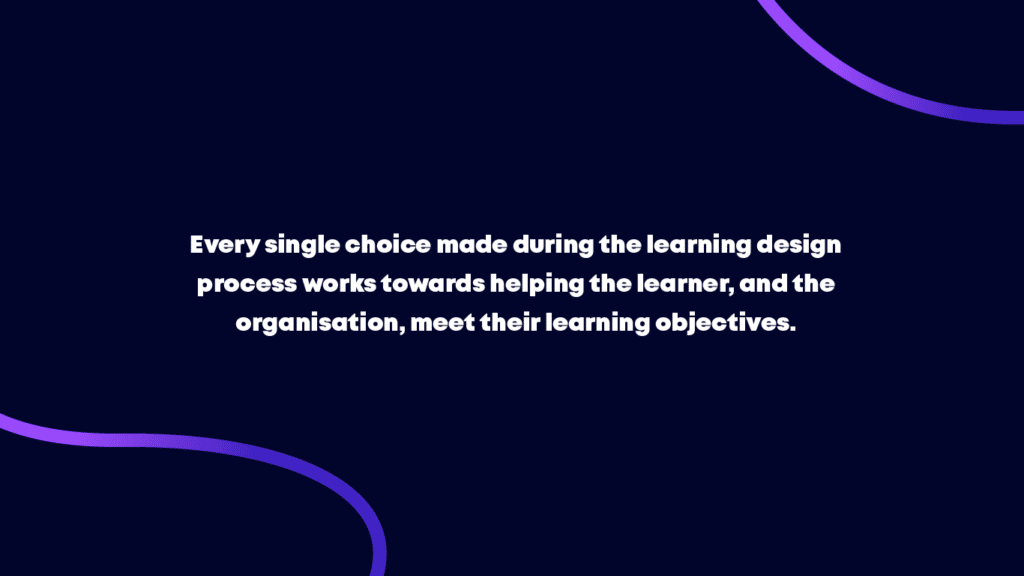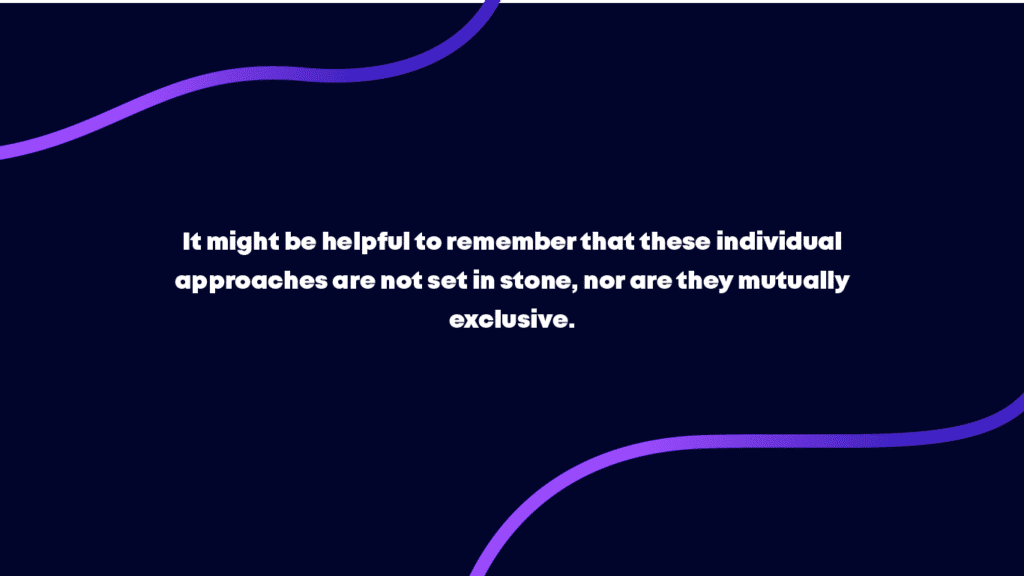Every journey worth taking can benefit from a little direction and support. Be it a good old-fashioned physical map or the GPS app on your handy smartphone, there is always comfort in the knowledge that if and when you need it, there is a plan to guide you along.
In the adventure that is online learning, this crucial role is played by learning design.
Think about it: it’s natural for learners to feel lost in an unfamiliar world of brand-new information and knowledge that is directed their way. Without any guidance, the learning process can easily become overwhelming, leaving learners confused about what they should focus on next (or why).
And as a company that is in the business of creating effective online learning programs, we can tell you that this challenge is just as prevalent in online learning settings as it is in physical classrooms!

But with the help of effective learning design, this challenge can be easily resolved. Learning design anticipates the needs, challenges, and goals of the learners and then makes informed decisions that give structure to the learning process in a way that suits them best.
It serves as the reliable, trustworthy roadmap you need when setting out on the adventure of learning. In the midst of all the new knowledge and skills on offer, learning design helps chart out a clear path for learners – and for the organisation behind the learning – and enables everyone to stay on track.
Want to know more about the wonders of learning design? Let us take you on an adventure of our own!
What is Learning Design?
Learning design is a series of informed choices about the various elements that go into learning, such as content, structure, sequence, activities, strategies, assessments, and more.
You might often see Learning Design described as a ‘discipline’, ‘practice’, or ‘framework’. And it can be all of those things in different contexts.
In learning design, every essential part of the learning experience is carefully selected and arranged to make learning as impactful and effective for the participant as possible.
Ultimately, through these informed choices, good learning design aims to accomplish two main goals:
- To develop the best possible learning experience for a specific type of learner, and
- To successfully meet a specific learning objective

Creating Effective Learner Experiences
Learning design understands that learning is not a one-size-fits-all approach. Different learners perceive and digest new information differently and respond differently to challenges. Which is why the objective of learning design is to create a learning journey that is unique to the specific group of learners they are designing the programs for.
After all, it is one thing to gather and create the content you need to build an online learning program. But it’s a whole other thing for your learners to experience that content in a way that is tailored to suit their specific needs and skill levels. This tailor-made manner of presenting that content is what helps learners internalise information better and retain it long after the program has ended. That is the role that good learning design plays.
Consider, for instance, that you are designing a learning program for a team of new recruits that is always on the go. The learning design process will factor in the skill levels of the learners (say: beginner) to determine the content and assessments on offer. It could also offer flexible online learning options that can be accessed and completed remotely, at the learner’s convenience.
If you’ve ever been a part of a course or online learning program, there’s a good chance you’ve interacted with learning design without really knowing it! And that’s the point of good learning design – to create an experience that educates and offers information in a way that feels natural, organic, and intuitive to the learner.
Meeting Learning Objectives
The other main purpose of learning design is to help learners meet the goals, or learning objectives, that are set out for them at the beginning of a learning program. It’s why setting the learning objectives themselves is such a crucial part of learning design!
When a learning program is designed around clear, measurable, and observable learning objectives, the road ahead becomes easier for everyone involved. Learners gain clarity on what they’re working towards, and why. Course creators and facilitators gain clarity on the direction and success of their program based on how well the learning objectives have been met.
For an organisation setting up an online training or employee skilling program, the learning objectives can often be part of a larger department- or company-wide initiative. The goals and expected outcomes of a single program can tie deeply into one or several business goals that the organisation is collectively working towards.
For instance, consider an online training program aimed at familiarising a workforce with new software. The learning objectives will clearly define what the employees should be able to achieve with the software by the end of the program and the impact it should have on their day-to-day workload.
The success of the program, then, is determined by whether or not, and to what degree, these objectives were truly met.
All choices made during the learning design process, such as what type of content or assessments to include, will keep these objectives in mind. The program might, for example, include video demonstrations and/or creative, practice tests to make sure the learners have the experiences they need to truly get comfortable using and playing around with the software.
This learning program could be part of a larger company-wide move to say, digitise existing records or streamline business processes with the aid of new tools. If this one online program were to be successful in meeting its learning objectives, it would go a long way in helping the organisation meet a crucial goal.

All of that is to say that defining learning objectives is essential to learning design because it forms the very foundation of a learning program. Every single choice made during the learning design process works towards helping the learner, and the organisation, meet those specific learning objectives.
Approaches to Learning Design
Now, if there is one thing you should take away about Learning Design, it is that there is no one right way to do it. The entire purpose of having learning design by your side is to be able to offer learning in a way that serves your learners and your learning outcomes best.
Remember: good learning design should be built on research and proven pedagogical principles. But it should also be flexible and versatile enough to change its approach based on the circumstances and objectives of the learning experience.
There are a number of unique ways to implement learning design into your own online learning programs. But a handful of broad learning design approaches usually make for a great starting point.
Note: It’s possible you’ve already seen a few of these terms in circulation, especially as learning underwent a huge change during the digital-learning demands of the pandemic!
Here is a brief run-down of some of the most popular learning design approaches:
Blended Learning:
The Blended Learning approach to learning design combines face-to-face learning with online learning components. For example, imagine a learning program that requires learners to attend in-person lectures as well as peruse online content and/or complete online activities.
The key thing to remember about the blended learning approach is that the online component supports and goes hand-in-hand with the in-person elements of learning, instead of entirely replacing them.
Hybrid Learning:
Hybrid Learning is often confused, or used interchangeably, with Blended Learning – and it’s easy enough to understand why. Like blended learning, the hybrid learning approach also involves elements from both in-person and online learning.
However, there’s one key difference. The online learning components are usually used to replace a part, if not the entirety, of the in-person learning component. So a typical hybrid learning program would, for example, have some learners participating entirely in person while others participate entirely online.
Flipped Learning:
On the surface, Flipped Learning might seem like yet another learning design approach that combines online and in-person learning components. But there’s a unique reason it stands apart from the other two approaches we’ve mentioned.
READ: Claned’s Glossary of Online Learning Jargon
In traditional learning programs, learners are expected to consume the course content in class and then further build upon the knowledge they’ve acquired, outside the class. However, flipped learning encourages learners to build a fundamental level of knowledge about the topic at hand before going ‘into the class’.
Consider a learning program that offers course materials as well as live sessions and activities with an instructor, for every module in the course.
With a flipped learning approach, all learners would be required to consume the course materials before they join their peers and the instructor for the live class session and activities. The goal with flipped learning is for learners to come into discussions and activities already armed with a basic understanding of the topic, thereby making the most of peer interactions and class time.
Asynchronous Learning:
Asynchronous learning can best be understood as learning that takes place at different times for different learners. Learners have the flexibility to take up learning at any time as per their own schedule and at their own pace, as long as this learning takes place within a specific timeframe.
Online learning programs that offer asynchronous learning usually feature pre-recorded lectures and require little to no real-time interactions with an instructor. Learners typically resolve queries and doubts by posting questions or participating in an online discussion forum with other learners in the course.
Social Learning:
This approach to learning design takes into account the many research-backed benefits of learners working together to learn better!
The social learning approach considers the ways in which learning is enhanced by learner interactions and collaborations, such as through comments, discussions, and group activities. When learners work together, they are far more likely to validate their knowledge and gain new perspectives than if they were learning by themselves.
Contrary to popular belief, the benefits of social learning are not limited to physical classrooms. Online learning programs can also be home to eager, bustling learner communities that interact more freely and openly when freed from the pressures of in-person learning.

Note: It might be helpful to remember that these individual approaches are not set in stone, and are not mutually exclusive by any means.
READ: 7 Questions to Ask Yourself Before Building an Online Course
A blended learning program could have flipped learning components, while a hybrid learning program almost always has asynchronous learning components included. Learning programs at Claned, no matter the overall approach, are always designed to get the most out of social learning components.
To develop a learning design approach that works best for your outcomes and organization, it’s a great idea to consider combining different elements of two or more of these approaches.
The Importance of Learning Design
Learning design is an essential field that intersects with various disciplines such as education, psychology, graphic design, user experience (UX), and more.
Here are why learning design is so important:
- Enhances Learning Outcomes: Well-designed educational materials can significantly improve comprehension and retention. By considering cognitive load theory and employing multimedia learning principles, designers can create content that aligns with how people naturally learn.
- Improves Engagement: A thoughtfully designed course or learning material can be more engaging for learners. Using interactive elements, storytelling, and relevant contexts keeps learners interested and motivated.
- Facilitates Accessibility: Inclusivity in design ensures that learning materials are accessible to individuals with disabilities. This means creating content that can be used by people with a range of abilities, backgrounds, and learning styles.
- Supports Personalization: Learning design allows for the personalization of education. Different learners have different needs, and a good design can cater to a diverse audience by providing various pathways through the content.
- Encourages Critical Thinking: When learning materials are designed to not just inform but also challenge learners, they promote critical thinking skills. Designing scenarios that require problem-solving or decision-making can enhance these skills.
- Adapts to Technology Trends: As technology evolves, so do the possibilities for learning design. Keeping up with trends like mobile learning, gamification, and virtual reality can make learning experiences more dynamic and effective.
- Promotes Efficient Teaching: Good design doesn’t just benefit learners; it also aids teachers and trainers. With well-structured materials, educators can spend less time on administrative tasks and more time on actual teaching.
- Supports Scalability: Properly designed courses are easier to scale up for larger audiences without diminishing the quality of instruction or learner experience.
- Encourages Collaboration: Learning design often involves collaborative efforts between subject matter experts, designers, technologists, and educators. This collaboration can lead to innovative approaches and shared best practices.
- Prepares for the Future of Work: As the job market evolves, so do the skills required to succeed in it. Learning design helps in creating educational programs that prepare individuals for future challenges and opportunities.
Remember, good learning design is not just about making things look pretty; it’s about creating an effective educational experience that is enjoyable, inclusive, comprehensive, and impactful!
What Makes Learning Design Work
The right learning design approach can set your online learning programs on the road to success from day one – proving effective for both your learners and your organisation’s bottom line.
But what does the ‘right learning design approach’ even look like? What should you be looking out for as you expend your valuable time, effort, and resources into the process?
As we mentioned before, there’s truly no right way to approach learning design. By its very nature, effective learning design must shape itself around the needs and circumstances of the learning environment. When participating in the process of learning design, we must discover for ourselves what works for the learning program’s unique purposes and objectives.
But even in the midst of this process of individual exploration and discovery, there are certain guiding principles that often prove helpful for learning designers.
These are the foundational best practices for learning design. Whether applied individually or in conjunction with each other, these principles are crucial in maximising the potential of your learning design efforts and improving the chances of success for your learning programs.
- Focusing on the humans: Good learning design has a deep understanding of exactly who it is designing for: the humans! By focusing on the people instead of the content, a learning program can easily prioritise its efforts in the most effective direction.
It is important for the learning design process to empathise with its learners and become intimately familiar with their skill levels, experiences, challenges and strengths. Only then can a learning program truly be deemed effective.
- Relying on research: This is where the ‘discipline’ part of learning design comes in. The various decisions made during the learning design process must draw from solid pedagogical research. There can often be an intuitive component to learning design.
But that does not discount the fact that learning design grounds itself firmly in pedagogical findings and strategies that have demonstrably proven their worth.
- Seeking feedback, and incorporating it: The learning design process benefits immensely from the insights gathered from everyone participating in the learning experience – learners and facilitators alike. Which is why it is important to have an understanding of the value of feedback from multiple sources and actively seek it from its participants.
This feedback gathered from people about the learning experience, coupled with research-backed principles and best practices, is how learning design zeroes in on a solution that actually works.
Conclusion: Learning Design at Claned
At Claned, be believe that learning design is an indispensable element in course-building. In fact, it’s one of the foundational principles on which we built Claned itself.
In the context of online learning programs, such as those we build on Claned, learning design goes a long way in bringing pedagogy and technology together. It helps make thoughtful, effective decisions on how to maximise technology in order to support or enhance the learning experience.
Our online learning platform, for instance, has been built to incorporate learning design principles right into the platform and user experience. The various modules, tools, and features on Claned have each been thoughtfully designed to offer effective learning in an online learning setting.
Learners find an intuitive learning program that fine-tunes a learner’s experience and nudges them towards choices that complement their learning styles. Course builders find a platform that makes smart recommendations based on research-backed pedagogical strategies. And all in all, organisations get the opportunity to set up and run entire learning programs that stand on solid learning design foundations.
So if learning is a journey indeed, then at Claned, we make sure our learners and clients always have the comfort of a trusted roadmap!
Want to create online trainings and learning programs built on the back of effective learning design? Reach out to us at sales@claned.com today!







